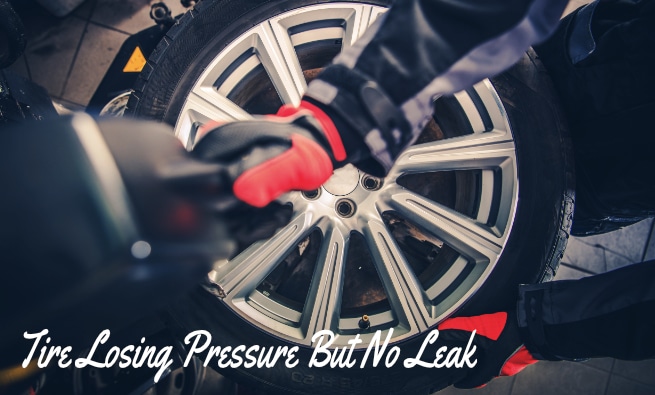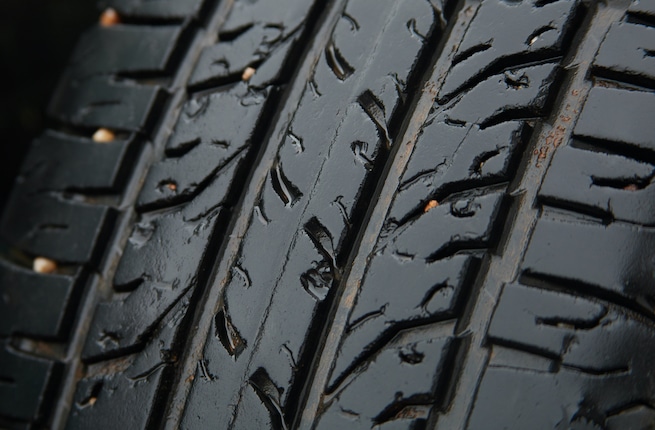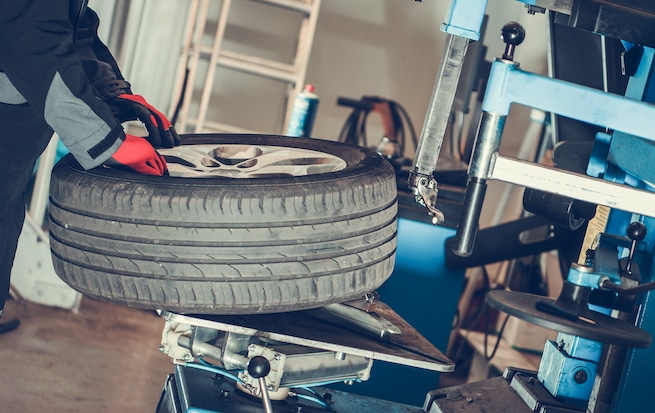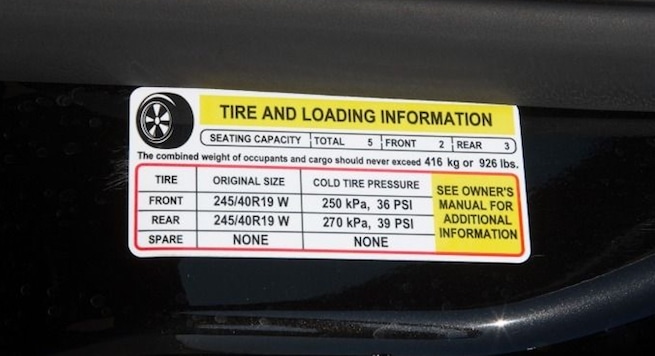Tire Losing Pressure But No Leak Is Found
Most people are familiar with tires suddenly going flat, usually from a nail puncture or some other damage to the tire. But what frustrates many consumers is the tire that slowly goes flat for seemingly no reason at all. So, you are here because you have a tire losing pressure but no leak is found?
Most tires keep losing air due to several reasons: loose valve stems, maybe a sharp object or nail puncture the tire, a corroded wheel or rocks causing a bead leak on the side of the wheel, or even a poor tire damage repair can let the air escape your tire. Slow tire leaks are common, and that is why you should know all the reasons why this is happening to your tire.
10 Reasons Why You Got Tire Losing Pressure But No Leak Is Found

If every couple of weeks you have to add air to your tires because the Tire Pressure Monitoring System gives you a warning that your tires keep losing air or you notice that the car tires are not handling as well as they used to because one or more of the tires are low on air, you may have one of these ten issues with your tires.
1. Loose or poor valve stems
The valve stem and the valve inside it may begin slowly leaking due to age or dirt in the valve. The stem, made of rubber, can deteriorate and crack, allowing air to escape slowly. Valve cores may not sit properly in the valve stem due to fine dust particles also allowing air to escape.
2. Visibly damaged or bent wheel
Hitting a curb or a deep pothole too hard can sometimes dent the rim, causing the rim of the tire to fit the steel rim improperly. Also, the impact may have broken the seal of the tire to the rim and allow air to slowly leak away. The tire sidewall can also be damaged.
3. Tires bead damage
The tire bead is the edge of the tire that rests on the rim. Air may leak from the area of the tire bead seat because an insufficient rim sealer was applied when the tire was installed, the rim was bent, or the tire bead was damaged. Bead leak is a common slow tire leak.
Spray soapy water where the bead meets the rim and watch for bubbles to form, indicating a slow leak. If you have a bead leak, it is recommended to remove all the air out of the tire to clean the bead seal. Sometimes you can get rocks or corrosion build up in this area, and you need to remove it.
4. Hole in the tire sidewall
A hole may form in the sidewall of the tire. A hole in the sidewall often occurs due to impact with a foreign object such as a curb or stone. Watch for abrasions on the sidewall of the tire, especially after hitting the curb, and check for air leaks using soapy water.
5. Sharp object or nail in the tire

Sharp objects such as nails, screws, or even sharply pointed stones can puncture a tire and act to seal the tire. There could also be a very slow leak. Although the tire does not go flat immediately, the leak is often significant, causing the tire to become flat after a few hours or overnight.
6. Tire damage caused by a road hazard
Road hazards such as potholes, rough roads, and debris on the road can cause extensive damage to the tires as well as the car’s suspension, including axles, alignment, and tire balancing. A pothole can damage the rim or the tire, for example, and cause a slow leak.
7. Hole in the thread
A pinhole air leak in the thread or a tire tread can occur from over inflation. However, tires heat up from driving at high speeds. This temperature change causes the pressure in the tire to increase. Air may escape through pinholes, or the tire may blow out, potentially causing an accident if it occurs at high speed.
8. Corroded wheel causing a bead leak
Steel tire rims corrode as they age, especially if they are exposed to salt in winter conditions. Corrosion along the rim can cause a poor seal allowing air to escape and tire pressure to slowly decrease. Drivers may have to invest in new rims to repair the problem.
9. Bad repair job or poor seal

Whenever a tire is changed, the tire technician uses a wire brush to scrape the rim to remove rust and any debris that could lead to a poor seal. Also, the rim is coated with tire sealant to help seal the tire bead to the rim. Plugs are installed to fill a hole created by a nail. If either of these functions is not completed properly, air can escape slowly, leading to low air pressure or a flat tire.
10. Missing valve cap
The valve cap protects the valve stem and the valve from dust and debris entering the valve stem. Dust can sometimes penetrate the valve stem causing a poor fit of the valve and the valve stem, allowing air to escape. A valve cap on each valve provides physical protection for the valve.
How To Locate A Tire Air Leak
Tire air leaks can be fairly fast, causing a tire to deflate over several hours, or slow leaks might take several days. Air leaks can sometimes be found by listening for the air escaping or running your hand over the tire to feel air escaping.
Slow air leaks are more difficult to find. One of the popular methods is to use a soapy liquid to search tires for air leaks. Spray the liquid over the suspected area and watch for bubbles of air to form as the air escapes. The liquid should be sprayed over the valve, along the bead-rim area, the sidewalls, and the tread area until the leak is located.
FAQ
The following are frequently asked questions about tire leaks, tire repairs, and finding the right pressure specifications for your tires and your vehicle.
Should I repair or replace a flat tire?
Most nail punctures in the tread area can be repaired with a plug, assuming that there is sufficient tread on your tire. Large punctures, damage to the tire sidewalls, and dented rims often require a new tire and even a new rim. A flat tire caused by a bad valve stem can easily be repaired. Tire beads that are not sealing properly to the rim can also be repaired by resealing the tire with the proper rim sealer after thorough cleaning of the rim.
Why does my tire lose air overnight?
Tires with a slow leak can lose air overnight for several reasons. A bad valve stem, a poorly sealed tire bead, a pinhole in the tread, or a damaged rim can all cause a slow air leak causing the tire to lose air overnight and even a total flat. Nails and screw nails are often picked up, puncturing tires and acting as a plug in the tire. Air escapes slowly, and drivers may not notice the problem until the next day.
Do tires lose air when a car is not driven?
Tires lose air all of the time due to small amounts escaping through various locations. Older tires tend to lose air more quickly. A car that has been allowed to sit for a long time may not lose air any more quickly than one that is driven.
However, it is more noticeable. Always check the air pressure of your tires before driving after the car has been parked for a long period to protect the tires and also provide safe traction and control while driving. Check both the drivers side tire and the passenger side tire.
How long does it take for a slow leak to flatten a tire?
If you suspect a tire is losing air through a slow leak, have it repaired immediately or replace the tire with your spare tire. The slow leak could cause your tire to go flat in an hour or 24 hours. Either way driving on a tire with low pressure can damage the structure of the tire and provide poor control and stability. Install your spare tire and have your tire repaired ASAP.
Why is my brand new tire losing air pressure?
Even brand new tires can lose air pressure. The tire could be defective; however, this is unusual. New tires tend to lose air if the installation of the tire on the rim was completed incorrectly or the valve stem is malfunctioning. Hitting a large pothole or debris on the road can also damage even new tires. Have your tires checked, do not drive on an underinflated tire, and have it repaired to avoid long-term damage to the tire.
How to find the recommended PSI of your set of tires?

There are two locations for drivers to find the recommended air pressure for tires on their vehicles. The manual will always have the recommended tire PSI in the specifications section.
Most vehicles will have a metal plate attached to the driver’s side door post providing recommended tire pressure for four tires, along with other information about your vehicle. Some car manufacturers attach this stamp to the underside of the hood.
Summary
Tires can leak air for many reasons. Nails, screw nails, glass, road hazards, hitting potholes or curbs, malfunctioning valve stem, and even corroded rims. Check your tire pressure often and top up to the recommended levels for your vehicle.
If a tire keeps losing pressure, have it repaired immediately to avoid damaging the tire further. Regular car maintenance should include checking tire pressures, oil change, and filter change. Hope you enjoy our take on air loss, and how we covered all of the common reasons tires may lose air and include car care tips.
Last Updated on: March 16, 2025

